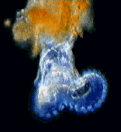Invertebrate
Zoology Rotifera
The
rotifers derived their name from the characteristic ciliated organ, the corona,
around lobes on the heads of these animals.
The cilia of the corona do not beat in synchrony; instead, each cilium
is at a slightly earlier stage in the beat cycle than the next cilium in the
sequence. A wave of beating cilia thus
appears to pass around the periphery of the ciliated lobes and gives the impression
of a pair of spinning wheels. (The
rotifers were first called “wheel animalicules.”)
Rotifers are small animals (0.1 to 3 mm in length) that are abundant in most freshwater habitats; a few (less than 10%) are marine. The approximately 2,000 species are divided into three classes. The body has about one hundred cells, and the organs are eutelic. Rotifers are usually solitary, free-swimming animals, although some colonial forms are known. Others occur between grains of sand. The only hard parts of rotifers are their jaws. Because of their mostly soft bodies and small size, rotifers are not commonly favored for fossilization.
 |
Phylum Rotifera
1.
Triploblastic, bilateral, unsegmented,
pseudocoelomate
2.
Complete digestive system, regionally
specialzed
3.
Anterior end often has a ciliated organ
called a corona
4.
Posterior end with toes and adhesive
glands
5.
Well-developed cuticle
6.
Protonephridia with flame cells
7.
Males generally reduced in number or
absent; parthenogenesis is common |
Return to the Invertebrate
Zoology Homepage